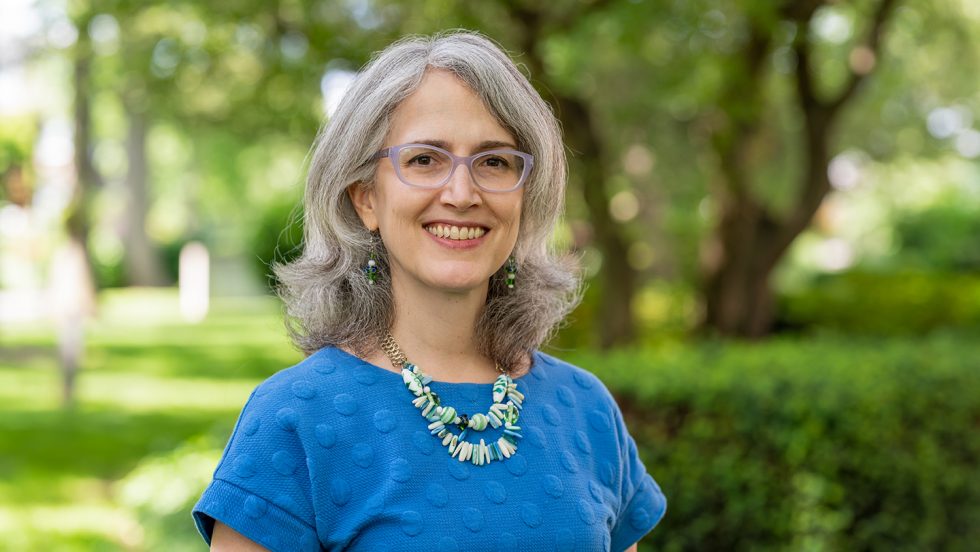
Brilliantly personalizing her teaching methods, Traci Levy, PhD, helps her political science students overcome presentation anxiety in group settings. She shared her approach and its great results in Inside Higher Ed.
Giving a presentation in class can be a daunting experience. For many students, standing in front of a group of 25 of their peers and explaining a complex concept is the stuff of nightmares and panic attacks.
Traci Levy, PhD, associate professor of political science and director of gender and sexuality studies, saw how stressed her students were when they had to give presentations in her introductory politics class at Adelphi. About three years ago, she decided to come up with a new format for presentation days, one that would lower the stress and increase the learning.
“I thought, ‘What if students were literally sitting around a table, like at a cafe, presenting information informally, sort of like friends discussing ideas?'” Dr. Levy explained. Deciding to give it a try, she divided her class into small groups and let them make their presentations around a table. She called her new approach the Presentation Café—an approach she wrote about earlier this year in “Helping Students Overcome Presentation Anxiety,” an essay published in Inside Higher Ed in March.
“I’m a pedagogy geek,” she admitted. “I love figuring out how to better connect the students with the material and each other.”
Taking the Pain Out of Presentations
Here’s how Presentation Café works. Dr. Levy groups her students into trios and assigns each group a country to research. Each student in the group gets a topic about the country and spends a few weeks preparing a presentation.
A recent Presentation Café assignment had each group research three aspects of political power in their assigned country—hard and soft power, legitimacy, and multilateralism. Group members were asked to collaborate with one another to make sure their presentations worked together.
On Presentation Café day, Dr. Levy stations the groups at tables in the classroom, along with an audience of three to six classmates who listen and ask questions. Each member of the group makes a three-minute presentation. After all three presentations have been made, the audience members rotate to a new table. The presenters stay in place to address a new group of listeners, eventually giving their presentations three times.
“Practice makes perfect,” Dr. Levy said. “They get more comfortable with their presentation skills by giving it multiple times in one class.”
Students Say the Approach Helps Them Learn
Dr. Levy’s students give the Presentation Café rave reviews. “No one could see your leg shaking under the table,” said Ana Martinez, a rising senior majoring in education. “It was much less intimidating to me. The professor wasn’t sitting in a corner watching you. There weren’t a bunch of students staring at you. It’s small groups of students and the professor walking around the room listening to you.”
Serica Lakhram, a rising sophomore majoring in nursing, said the less intimidating format of the Presentation Café helped her learn more about her topic, the legitimizing of power in North Korea. “I could remember more from my slides and was able to answer more questions from other students. I wasn’t frozen with fear.”
Martinez, who gave a presentation on multilateral efforts by Egypt’s government, said she had a better understanding of the topic. “I didn’t totally get it when I read about it,” she said. “But when I did a PowerPoint about it, and explained it to classmates three times, it made a lot more sense.”
New Approach Leads to Better Outcomes for Students
Dr. Levy hasn’t settled for anecdotal data as to whether Presentation Cafés have led to better educational outcomes. She had students answer an essay question on an exam about a subject covered in the presentations. Students scored higher on the essay and showed a better understanding of the concepts than students in previous semesters did after traditional presentation days. “Correlation isn’t necessarily causation,” Dr. Levy wrote in the Inside Higher Ed article about her new approach. “Multiple factors could be at play with the higher scores.” But she says she’s pleased to see fewer of her students score “unsatisfactory” on the essay and more score “satisfactory” and “superior.”
Martinez was so pleased with Dr. Levy’s approach that she took another political science class with her. “I didn’t know how much I liked political science until Professor Levy showed me how interesting it is.” And Martinez is learning even more from Dr. Levy. She’s also getting ideas on how to be a better teacher. “I actually used Presentation Café in one of my student lesson plans,” she says. “I see how that approach can help students.”
Martinez has no doubts that the Presentation Café helped her learn. “Normally when I go up and do a presentation, it’s like blurred vision. I’m so nervous that I try not to look at anyone,” she said. But when she did a presentation in a small group, she stopped being afraid and soaked up the material. She also learned from other students. “I was able to get closer with everyone else,” she said. “I could see them nod their head when I spoke and get what I was saying. You realize you’re in the same boat. You connect.”
Read Dr. Levy’s essay, “Helping Students Overcome Presentation Anxiety,” published in Inside Higher Ed on March 23.